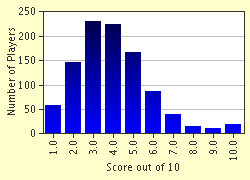Quiz Answer Key and Fun Facts
1. How hot is the core of the sun?
2. Mercury has an atmosphere.
3. How long (in Earth days) is a day on Venus?
4. What is the largest (by volume) freshwater lake on Earth?
5. Which of the following is NOT a name given to Mars at some point in time?
6. Jupiter has a ring system.
7. Who was the first person to determine that Saturn had a ring system?
8. Discovered in 1787, the first two moons of Uranus were named for which Shakespearean characters?
9. How fast can the winds of Neptune travel?
10. If the Sun were reduced in size to 10 feet (3 meters) in diameter, approximately how far away would Pluto be, on average?
Source: Author
emillard
This quiz was reviewed by FunTrivia editor
rossian before going online.
Any errors found in FunTrivia content are routinely corrected through our feedback system.


